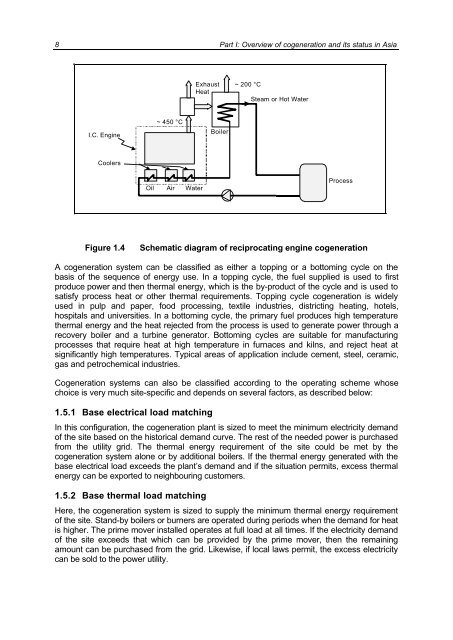part 1: overview of cogeneration and its status in asia - Fire
part 1: overview of cogeneration and its status in asia - Fire
part 1: overview of cogeneration and its status in asia - Fire
Create successful ePaper yourself
Turn your PDF publications into a flip-book with our unique Google optimized e-Paper software.
8 Part I: Overview <strong>of</strong> <strong>cogeneration</strong> <strong>and</strong> <strong>its</strong> <strong>status</strong> <strong>in</strong> Asia<br />
I.C. Eng<strong>in</strong>e<br />
Coolers<br />
~ 450 °C<br />
Oil Air Water<br />
Exhaust<br />
Heat<br />
Boiler<br />
~ 200 °C<br />
Steam or Hot Water<br />
Process<br />
Figure 1.4 Schematic diagram <strong>of</strong> reciprocat<strong>in</strong>g eng<strong>in</strong>e <strong>cogeneration</strong><br />
A <strong>cogeneration</strong> system can be classified as either a topp<strong>in</strong>g or a bottom<strong>in</strong>g cycle on the<br />
basis <strong>of</strong> the sequence <strong>of</strong> energy use. In a topp<strong>in</strong>g cycle, the fuel supplied is used to first<br />
produce power <strong>and</strong> then thermal energy, which is the by-product <strong>of</strong> the cycle <strong>and</strong> is used to<br />
satisfy process heat or other thermal requirements. Topp<strong>in</strong>g cycle <strong>cogeneration</strong> is widely<br />
used <strong>in</strong> pulp <strong>and</strong> paper, food process<strong>in</strong>g, textile <strong>in</strong>dustries, district<strong>in</strong>g heat<strong>in</strong>g, hotels,<br />
hospitals <strong>and</strong> universities. In a bottom<strong>in</strong>g cycle, the primary fuel produces high temperature<br />
thermal energy <strong>and</strong> the heat rejected from the process is used to generate power through a<br />
recovery boiler <strong>and</strong> a turb<strong>in</strong>e generator. Bottom<strong>in</strong>g cycles are suitable for manufactur<strong>in</strong>g<br />
processes that require heat at high temperature <strong>in</strong> furnaces <strong>and</strong> kilns, <strong>and</strong> reject heat at<br />
significantly high temperatures. Typical areas <strong>of</strong> application <strong>in</strong>clude cement, steel, ceramic,<br />
gas <strong>and</strong> petrochemical <strong>in</strong>dustries.<br />
Cogeneration systems can also be classified accord<strong>in</strong>g to the operat<strong>in</strong>g scheme whose<br />
choice is very much site-specific <strong>and</strong> depends on several factors, as described below:<br />
1.5.1 Base electrical load match<strong>in</strong>g<br />
In this configuration, the <strong>cogeneration</strong> plant is sized to meet the m<strong>in</strong>imum electricity dem<strong>and</strong><br />
<strong>of</strong> the site based on the historical dem<strong>and</strong> curve. The rest <strong>of</strong> the needed power is purchased<br />
from the utility grid. The thermal energy requirement <strong>of</strong> the site could be met by the<br />
<strong>cogeneration</strong> system alone or by additional boilers. If the thermal energy generated with the<br />
base electrical load exceeds the plant’s dem<strong>and</strong> <strong>and</strong> if the situation perm<strong>its</strong>, excess thermal<br />
energy can be exported to neighbour<strong>in</strong>g customers.<br />
1.5.2 Base thermal load match<strong>in</strong>g<br />
Here, the <strong>cogeneration</strong> system is sized to supply the m<strong>in</strong>imum thermal energy requirement<br />
<strong>of</strong> the site. St<strong>and</strong>-by boilers or burners are operated dur<strong>in</strong>g periods when the dem<strong>and</strong> for heat<br />
is higher. The prime mover <strong>in</strong>stalled operates at full load at all times. If the electricity dem<strong>and</strong><br />
<strong>of</strong> the site exceeds that which can be provided by the prime mover, then the rema<strong>in</strong><strong>in</strong>g<br />
amount can be purchased from the grid. Likewise, if local laws permit, the excess electricity<br />
can be sold to the power utility.









